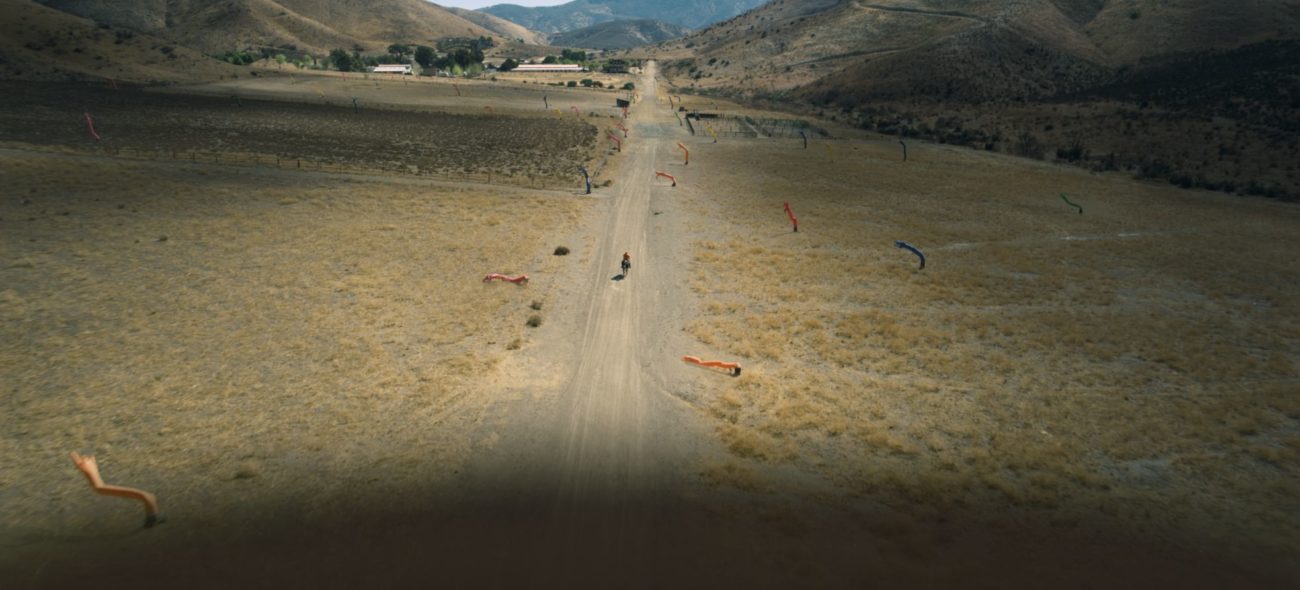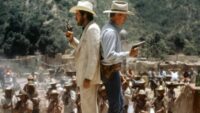As admittedly peculiar as it is to say, the most dependable places of comprehension and safety, as it were, for a viewer to latch onto in Jordan Peele’s Nope are the horses. Yes, of all places, the hooved colts and mares with no dialogue offer you the straightest reads of every alarming moment and situation in this film. Now, what that says comparatively about the humans, predicaments, and otherworldly elements working beside them is an entirely different thing.
With the tangent-spinning risk of having this film review, right out of the gate, sound like it is channeling 1998 Robert Redford or being published by Horse and Hound magazine, much to the joking delight of the Notting Hill fans out there, please know this appreciation and observation has its proven validity, even when applied to a twisted science fiction thriller. Horses are among the most intuitive animals in the world when it comes to sensory processing and sensory awareness. They unquestionably rely on their instincts at the physical, mental, and emotional levels in assessing life and death situations.

To put it more casually and in a way fitting the movie, horses say “nope” with fight-or-flight responses faster than and far before us humans. When Nope pushes your buttons and raises your pulse rate, follow what the horses do and you’ll fare well. Alas, we know humans behave differently and so does Jordan Peele. He knows man’s curiosity, perceived dominance, and other courage-warping temptations bend people to test survivability beyond their instinctual triggers until their own exit point or fatal failure.
Working damn hard to disprove the old Hollywood adage of “never working with children or animals,” Jordan Peele lets those horses be the first and strongest vessel of many put through the survival wringer of Nope. With an ancestral homage to the black jockey of Eadweard Muybridge’s “Animal Locomotion” early film experiments of the 1880s, the brother and sister team of OJ Haywood (Academy Award winner Daniel Kaluuya) and Emerald Haywood (recent Alice star Keke Palmer) work as show business animal wranglers specializing in horses. He’s the introverted farmhand and she’s the talkative and unfiltered face of the operation bequeathed to them by their deceased father Otis Sr. (the golden-throated Keith David).

The homebase of Haywood’s Hollywood Horses is located outside of Aqua Dulce in southern California. The ranch’s nearest neighbor is the “Jupiter’s Claim” western-themed entertainment park run by grown-up child actor Ricky Park (Minari Oscar nominee Steven Yeun) and his wife. His dubious shingle of fame is being the survivor of a horrific on-set incident where a trained sitcom chimpanzee turned on his cast and handlers. He feigns having lucrative happiness and closure, but the trauma has never gone away.
Speaking of tragedy, six months prior to the present time of Nope, Otis Sr. was killed atop his steed by deadly debris inexplicably falling from the sky. Nothing in Aqua Dulce has been the same since, as OJ and his horses, and soon Emerald and their newfound techy friend Angel (The OA’s Brandon Perea), begin to witness and encounter unexplained sounds and flying phenomena emanating from a cloud on the horizon that never seems to move with the rest of the weather. The prevailing hypothesis is, naturally, aliens. Cue the Dramatic Chipmunk!
That infusion of science fiction cements a threatening and interesting premise for Jordan Peele. The first two-thirds of Nope sinks into it deeper and deeper to evoke both comedy and horror at any given moment, two specialties of the Get Out and Us Oscar winner. Hilariously according to Angel, there are only three reasons why aliens would come to Earth: 1) To seek peace, 2) It’s our future selves going back in time to prevent destruction, and 3) The world killer variety. That’s a sound list, and those possibilities prod which characters cower in fear and which are drawn to the danger.

This escalation of frazzle and nerves also typifies the title of the picture. What a word! Go ahead and count how many times “nope” is dropped when something wild happens or when a peer asks another if they’re doing good. We, the audience, borrow that word ourselves to select which points we would be packing up and running for the hills out of Aqua Dulce. At the same time, viewers get to extrapolate how many horrific events could have been stopped or prevented by the uttering of and subsequent follow-through of action sprung by that quick word of refusal and exit.
Every time whatever is in that cloud comes near, the electrical power drops creating silence and darkness. Employing crack sound design work that booms in the IMAX format, these moments of mood change amplify the shrill symphony of terrifying noises that announce the presence of the unseen force of nature from above. True to Jordan Peele’s talent for suspense, Nope has many thrilling sequences brightened in some moments to shock us and shrouded in others to rattle our cages. The artistic engines for that anxious ambiance are ace cinematographer Hoyte Van Hotema (Tenet, Interstellar) and Peele’s trusty regular composer Michael Abels, both doing stellar work.
This high-wire act of fierce endurance has become Peele’s personalized playground for three feature films after making the jump from comedy television. Within his niche landscape, Peele is also one of the most exotic cinematic horticulturists, so to speak, we’ve ever seen. Few storytellers plant suggestive seeds of messaging and symbolism as sturdy or as deep as he does in his films. The challenges with his films, in that regard, have been the attention paid to which seeds and the eventual consequences of their outcomes.
Let’s start with the attention factor. That half of the difficulty rears an ugly head in Nope, and one that is getting scratched far more often than it should. From an intimidating opening Bible verse scourging the filth and vileness of man to the self-important chapter cards given to the names of OJ’s horses, there are cues and clues to be had everywhere in this film. Granted, that’s a credit to screenplay detail from Peele and the application of those elements through the production design of Ruth De Jong (Manchester By the Sea), the props from veteran TV property master Michael Glynn, and the striking visual effects of Guillaume Rocheron (Ad Astra). Even a single blood-splattered child’s shoe that can inexplicably stand on its toe cap elicits head-tilted dazzlement that gets the juices flowing.

However, Peele piles on the screenplay fertilizer for some seeds while leaving others barren with the California desert. Avoiding spoilers, the characters or anecdotes in Nope given the most dedicated caretaking end up being unimportant, causing the overall effort to be questioned. Look no further than the rich character history given to Steven Yeun’s sideshow Ricky Park versus the lack of growth or change awarded to Daniel Kaluuya and Keke Palmer’s main characters who dominate the screen time. No offense to the Judas and the Black Messiah Oscar winner or the former Akeelah and the Bee breakout, but maybe this should have been Yeun’s movie.
That said, the overall goal has to be compelling by the end of all the mystery. With all that is packed into Nope, the grand sum is little more than a band of citizens trying to get a single shred of video or photographic proof of alien existence for a tabloid cash-in. That kind of chosen outcome feels too slight when coming from all the foreboding ominousness it took to get there.
From there, the entirety of Nope adds up to a sometimes wobbly balance of consequential and inconsequential outcomes because of those suspiciously selective and disproportionate points of focus. Peele was rightly coy and wise to scatter so much misdirection and symbolism overload. Investing an audience in fleshing out their own discovery is a welcome exercise if the culmination can justify the journey. In a frequently exquisite and stylized fashion, right down to the herky jerky tube men imagery, Nope toes the line of keeping viewers entertained in the dark without making them feel too stupid.




